 advertisements advertisements
|

|
Astronaut Jerry Carr, who led NASA's final Skylab crew, dies at 88
August 26, 2020 — Former NASA astronaut Gerald "Jerry" Carr, who in 1973 led the record-setting, final mission on the first U.S. space station, Skylab, has died at the age of 88.
Carr's death on Wednesday (Aug. 26) was confirmed by his family in a statement shared by the Astronaut Scholarship Foundation.
"Throughout his life and career, Jerry Carr was the epitome of an officer and a gentleman. He loved his family, he loved his country and he loved to fly. We are all enormously proud of his legacy as a true space pioneer and of the lasting impact of his historic mission aboard America's first space station. We will remember him most as a devoted husband, father, brother, grandfather and great grandfather. We will miss him greatly," the family's statement read.
An aeronautical engineer and naval aviator, Carr was selected by NASA for its fifth group of astronauts in 1966, alongside future moonwalkers and other Skylab crew members.
Carr's first and only spaceflight was as the commander of Skylab 4 (also referred to as SL-4 or "Skylab 3" as appeared on the crew's mission patch). The third of three crewed stays of increasing duration aboard the orbital workshop, Carr and his Skylab 4 crewmates, Ed Gibson and William "Bill" Pogue, set what was then a record spending 84 days in space.
"We proved, I think, just absolutely, positively that the human being can live in weightless environment for an extended period of time," Carr said during a NASA oral history interview in October 2000. "But medically, we gathered the data that I think gave the Russians and other people the understanding and the courage to say, 'Okay, we can stay up for longer periods of time.'"
"NASA and the nation have lost a pioneer of long duration spaceflight," NASA Administrator Jim Bridenstine said in a statement. "We send our condolences to the family and loved ones of astronaut Gerald 'Jerry' Carr, whose work provided a deeper understanding of life on Earth and in space."
Rookie record
The Skylab 4 crew launched on Nov. 16, 1973, on board an Apollo command module atop a Saturn IB rocket from NASA's Kennedy Space Center in Florida. Carr, Gibson and Pogue were NASA's first all-rookie crew since Neil Armstrong and David Scott lifted off on the Gemini 8 mission seven years earlier.
"I was delighted to get a seat, and I was absolutely floored that they would select me to be a commander," Carr said. "So, I was really flabbergasted to be selected and very happy to do it."
Carr and his crewmates divided responsibilities aboard the Skylab space station. Gibson led performing the mission's planned science experiments, including solar physics studies. Pogue was charged with overseeing the fluid systems.
"My main task was the Skylab navigational guidance," said Carr. "We structured ourselves so that all of us could operate anything, but if anything went wrong there was one expert."
In addition to collecting physiological data related to their extended time in space, Carr and his crew continued the Earth and solar observations that began during the first two expeditions to the station.
"One of the things that Ed and Bill and I decided early, probably halfway through our training program, was that we really wanted to have extra film, we wanted to get briefings from people around the world who were experts in different kinds of Earth phenomena, because, as we said in those days, we did not want to be in the position at a debriefing of having someone ask us about something and being able to say nothing more than, 'Yeah, we saw it. Sure was pretty.'" Carr said.
NASA organized 40 hours of training with 20 leading experts to instruct the crew on what to look out for when observing the planet below.
"That turned out to be probably the most exciting and the most rewarding of all of the experiments that we did, [because of] the opportunity to ad lib — and to ad lib intelligently," Carr recalled.
The astronauts also had the chance to observe a recently-discovered comet as it neared the sun. The crew was provided a far-ultraviolet camera to image Comet Kohoutek and it was used during two spacewalks, including one on Dec. 25, 1973.
"[The comet] looked like it was going to do perihelion [the point closest to the sun] about Christmas Day of '73," explained Carr. "The period of the comet was 2,000 years, so there was a lot of talk that maybe that's what the Star of Bethlehem was, [it] was actually that comet, because of the biblical stories of this new star."
"Everybody, [even those] on the ground, thought that it was going to be a beautiful, brilliant comet, and it turned out to be very faint," he said. "We really had to work to find it. And once we found it, it was a gorgeous little thing, but it was really small and faint."
Including the Christmas spacewalk, Carr performed three extravehicular activities (EVAs) to conduct photography, replace film cassettes and recover experiments.
Miscommunicated 'mutiny'
NASA, looking to maximize the return on the astronauts' 84 days in space, filled the crew's daily schedules with activities and experiments. This quickly led to Carr, Gibson and Pogue having to give up their free time just to keep up with the load. So, when they chose to take an impromptu day off, it was misconstrued by some journalists to be a mutiny against mission control.
"We got to the point where the morale was low. We weren't feeling too good. We were getting tired. So we said, 'Let's take our day off and maybe a good day's rest will get us back in good shape again,'" Carr recalled. "We took our day off and did what we wanted to do."
That apparently included forgetting to configure their radios to receive calls from the ground during on orbital pass.
"People on the ground called us and we didn't answer them, so the press just thought that was wonderful," Carr recounted. "They said, 'Look at that, these testy old crabby astronauts up there won't even answer the radio now. They've turned off their radio and they won't listen to the people on the ground.'"
"So we have lived under that stigma [of a "mutiny"] all these years, but basically it was we just got careless and we were busy doing other things and didn't think to configure our radios," he said.
A subsequent call with the mission planners resulted in a lighter work load and the crew was still able to complete all of the planned experiments for the mission, plus "a lot of extra ones that we dreamed up," said Carr.
Carr, Gibson and Pogue splashed down on Feb. 8, 1974, having traveled 34.5 million miles (55.5 million kilometers) while circling the planet 1,214 times.
Carr logged a total of 2,017 hours, 15 minutes and 32 seconds in space, a world record at the time, including 15 hours and 51 minutes on his three spacewalks.
Almost to the moon
Gerald Paul "Jerry" Carr was born on Aug. 22, 1932 in Denver Colorado, but he considered Santa Ana, California, where he was raised, his home town.
Carr earned Bachelor of Science degrees in mechanical engineering from the University of Southern California in 1954 and in aeronautical engineering from the U.S. Naval Postgraduate School in 1961. He received his Master of Science in aeronautical engineering from Princeton University in 1962.
He enlisted in the U.S. Navy in 1949, and was appointed a midshipman with the Naval Reserve Officer Training Corps detachment at the University of Southern California the following year. Carr was commissioned in the U.S. Marine Corps in 1954 and underwent flight training at Naval Air Station Pensacola, Florida, and Naval Air Station Kingsville, Texas, before being assigned to Marine All-Weather-Fighter-Squadron 114, flying the F-9 and F-6 in the U.S. and the Mediterranean.
After postgraduate training, he served with Marine All-Weather-Fighter-Squadron 122, flying the F-8 Crusader in the U.S. and Far East. Carr was serving as a test conductor with Marine Air Control Squadron Three, flying the F-4 Phantom, when he was selected as a member of "The Original Nineteen" to begin training as a NASA astronaut.
Prior to commanding the Skylab 4 crew, Carr joined a group developing the Apollo lunar module, the spacecraft that would land the first humans on the moon.
"I became part of a group of guys who were responsible for following the lunar module through its development and fabrication and delivery, testing and delivery to the Cape," he said. "As they built the lunar module, we would do the testing of the systems as they were put in."
Carr then served on the support crews for Apollo 8, the first mission to launch humans to orbit the moon, and Apollo 12, the second lunar landing, and worked as a capsule communicator (capcom) in Mission Control for both flights.
"I really was thrilled to be part of Apollo 8. It was really a monumental mission, very gratifying to be part of it," he said.
Carr also worked on the development of the lunar roving vehicle (LRV, or lunar rover) and was in line to go to the moon himself, when his likely assignment, the Apollo 19 mission, was canceled.
"Fred Haise was going to be the CDR [commander], Bill Pogue was to be the command module pilot and I was to be the lunar module pilot," Carr said. "It was around 1970, early 1970 or so, when it was decided that Apollos 18, 19, and 20 would be canceled."
"We had lost our opportunity to go to the moon. I remember we moped around for quite a few weeks," Carr said, adding that it was soon after that he was offered the command of Skylab 4.
After his 84 days in space, Carr led a group working on the development of the space shuttle before retiring from NASA in June 1977 (he retired from the Marines with the rank of colonel two years earlier).
Life's legacy
Carr continued working in support of the space program, leading companies that offered consultant and support services to NASA. In 1984, he founded CAMUS, Inc., which served as a subcontractor to Boeing in designing the crew systems for the International Space Station.
For his years of service and contributions to NASA and the aerospace industry, Carr was bestowed an honorary Doctorate of Science in aeronautical engineering from Parks College of Saint Louis University, Illinois in 1976 and was awarded the 1974 Fédération Aéronautique Internationale Gold Space Medal in 1974. That same year, the Gerald P. Carr Intermediate School in Santa Ana, California, was named in his honor.
Carr and his fellow Skylab astronauts were honored with the 1973 Collier Trophy and the 1975 Goddard Memorial Trophy, among other awards.
Carr was inducted into the U.S. Astronaut Hall of Fame at NASA's Kennedy Space Center in Florida in 1997.
In 2008, author David Shayler worked with Carr to write "Around the World in 84 Days: The Authorized Biography of Skylab Astronaut Jerry Carr," as published by Apogee Books.
Carr is survived by his wife, Patricia Musick Carr. He had six children by his first wife, JoAnn Petrie Carr, who also survives him, including Jennifer Carr, Jamee Carr Wilson, Jeffrey Carr (and spouse Mengo Carr), John Carr, Jessica Carr (and partner Joy Ridout) and Joshua Carr (and husband Ray Limon).
His three stepdaughters are Cathleen Musick, Melinda Musick King (and spouse Tim King) and Laura Musick Wright (and spouse Greg Wright). He is also survived by 12 grandchildren and eight great-grandchildren. |
|
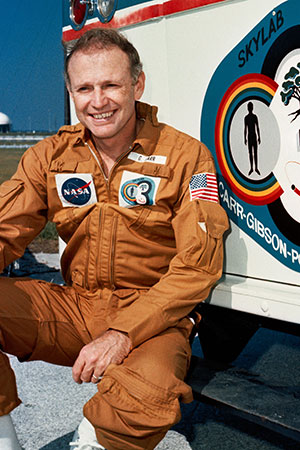
Skylab 4 commander Gerald "Jerry" Carr led his two crewmates on a record-setting 84-day-long stay on board the first United States space station in 1973. (NASA)
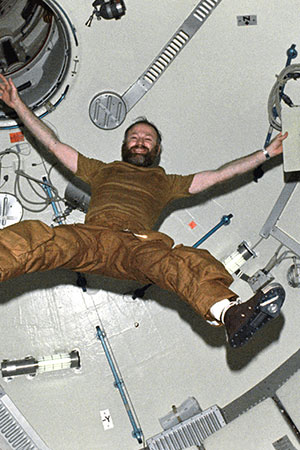
NASA astronaut Gerald "Jerry" Carr floats aboard the Skylab orbital workshop during its third, longest and final mission. (NASA)
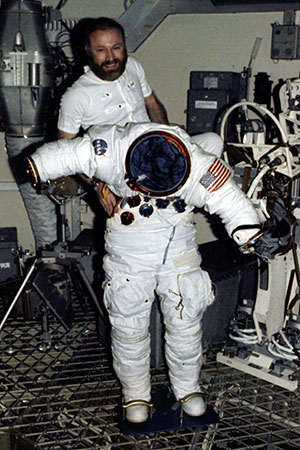
Gerald "Jerry" Carr, Skylab 4 commander, is seen partially suited for a spacewalk aboard the Skylab orbital workshop. (NASA)
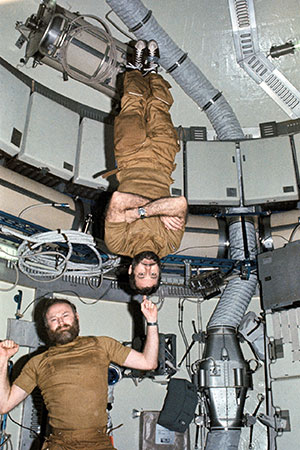
Skylab 4 commander Gerald "Jerry" Carr demonstrates his strength by balancing Bill Pogue on his finger in microgravity. (NASA)
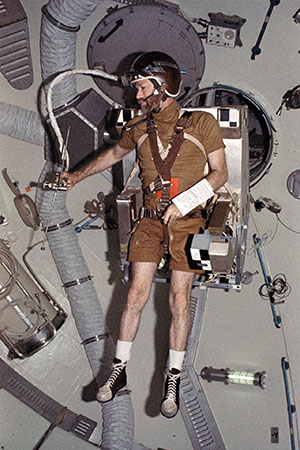
Gerald "Jerry" Carr, Skylab 4 commander, test flies the Astronaut Maneuvering Equipment M509 Experiment, a predecessor to the Manned Maneuvering Unit, on the Skylab space station. (NASA)
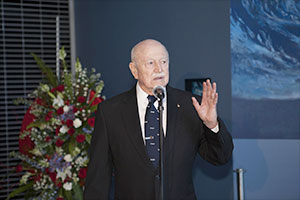
Gerald "Jerry" Carr speaks at a 2014 wreath laying ceremony for his late Skylab 4 crewmate Bill Pogue at the U.S. Astronaut Hall of Fame at Kennedy Space Center in Florida. (NASA/Kim Shiflett) |
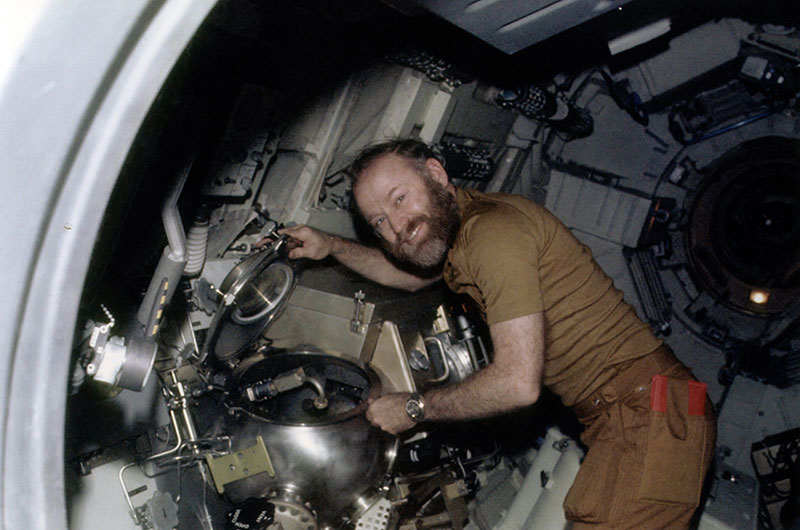
Skylab 4 commander Gerald "Jerry" Carr works aboard the United States' first space station during its third, final and longest mission in 1974. (NASA) |
|

© collectSPACE. All rights reserved.
|
|

|

|
